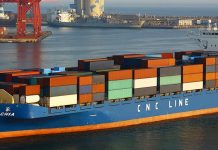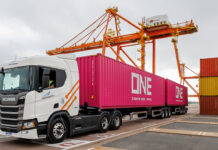
MSC and other opportunistic regional carriers have led the retreat in Transpacific capacity, according to Alphaliner’s latest report.
As of this month, we have seen 514 ships of 4.86 million TEUs, down from 674 ships of 5.56 million TEUs in June 2022. Most of the withdrawn vessels were from MSC and other long-haul newcomers who exited when the Covid-fuelled boom ended.
MSC removed just under 400,000 TEUs or 35% of its Transpacific capacity.
By the end of this month, following China United Lines (CULines) decision to axe its China-US West Coast service, all newcomers which joined the trade during the extraordinary years will have retreated, except Swire Shipping.
In June 2022, the fleet deployed by newcomers such as CULines, SeaLead Shipping, Pasha Hawaii, Transfar Shipping, TS Lines, BAL Container Line and Shanghai Jin Jiang Shipping comprised nearly 138,800 TEUs (or 2.5% of the total fleet).
Fleet capacity deployed between Asia and North America is down 12.6% year-on-year despite overall 5.4% fleet growth in the same period.
Maersk and MSC have with their vessel-sharing partner ZIM (for the US East Coast) reduced their joint 2M offering by 7%. The overall capacity withdrawal of MSC and Maersk Line (-19%) is however much higher as they ended standalone loops which were launched during the Covid-19 pandemic to take quick advantage of the booming market.
Alphaliner explained, “It remains remarkable that despite the closure of several services, MSC still deploys more capacity in standalone loops (232,700 TEUs) than in 2M services (145,500 TEUs). MSC thus remains the largest carrier on the trade offering non-alliance services, with a fleet twice as big as the number two, which is Wan Hai Lines. Similar to ZIM, Wan Hai Lines has taken delivery of larger newbuildings which entered the market after it had cooled down. Despite the introduction of five 13,000 TEU newbuildings, the Taiwanese carrier managed to reduce its fleet on the trade by 33% by closing many small loops and only retaining two big loops to/from the US West Coast (AA3) and East Coast (AA7).”
Most of the carriers which entered the Transpacific trade when volumes and freight rates peaked, deployed relatively small tonnage, which are now loss-making as spot freight rates fall below pre-pandemic levels.
Asia-US West Coast rates are now down to US$1,200/FEU in mid-June, sharply lower than the US$7,600/FEU seen in June 2022 and US$1,550/FEU in January 2020, before the pandemic. Asia-US East Coast rates have fallen from more than US$10,000/FEU in June last year to US$2,100/FEU today. In comparison, in January 2020, these rates stood at US$2,900/FEU.
Martina Li
Asia Correspondent





